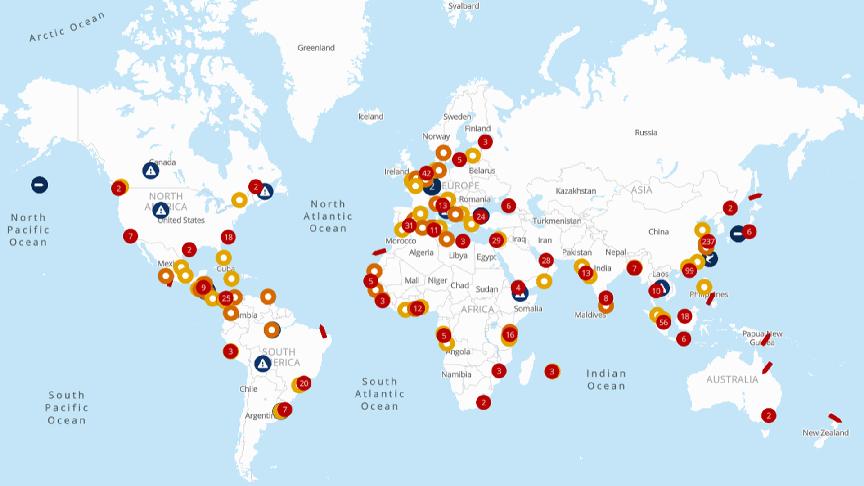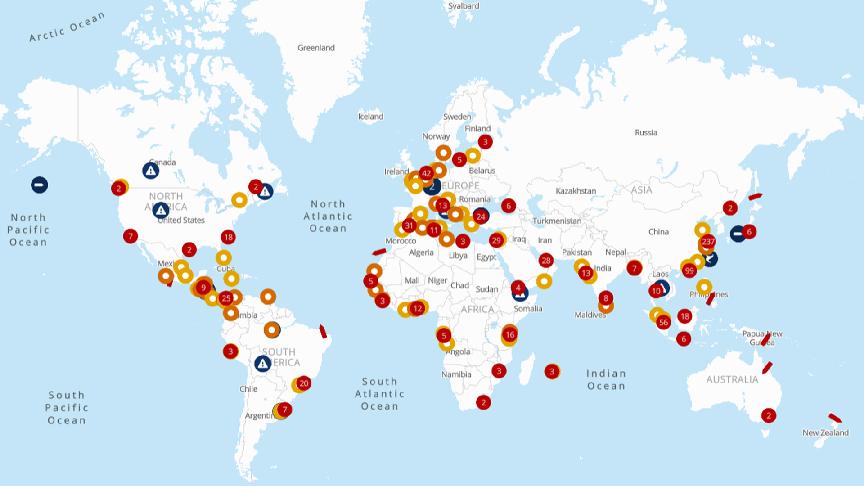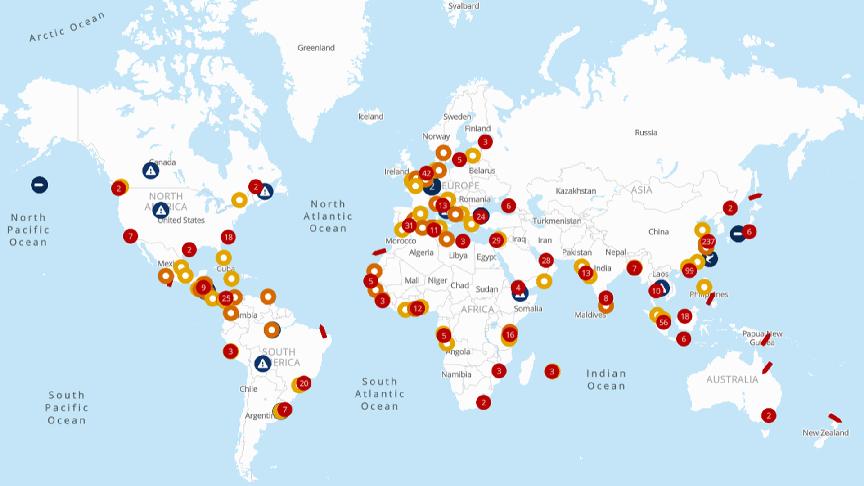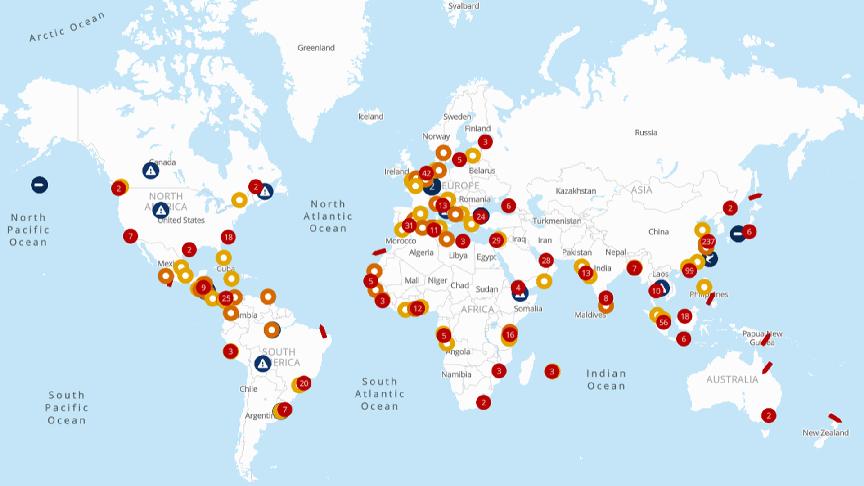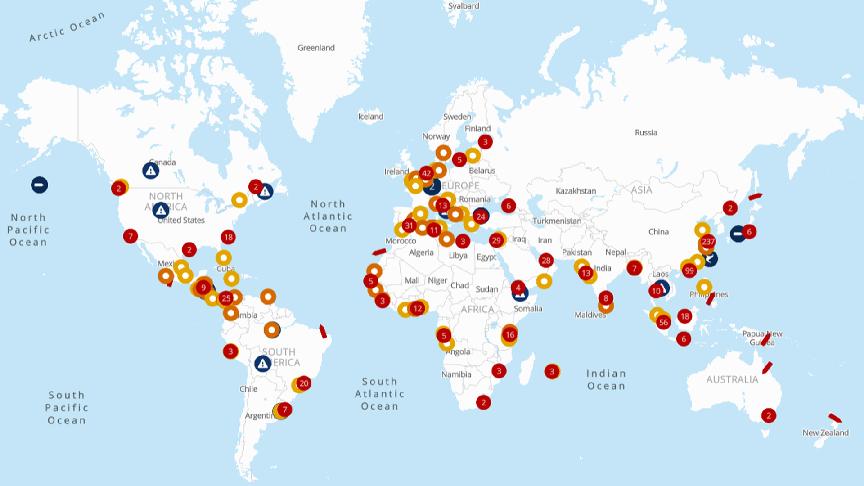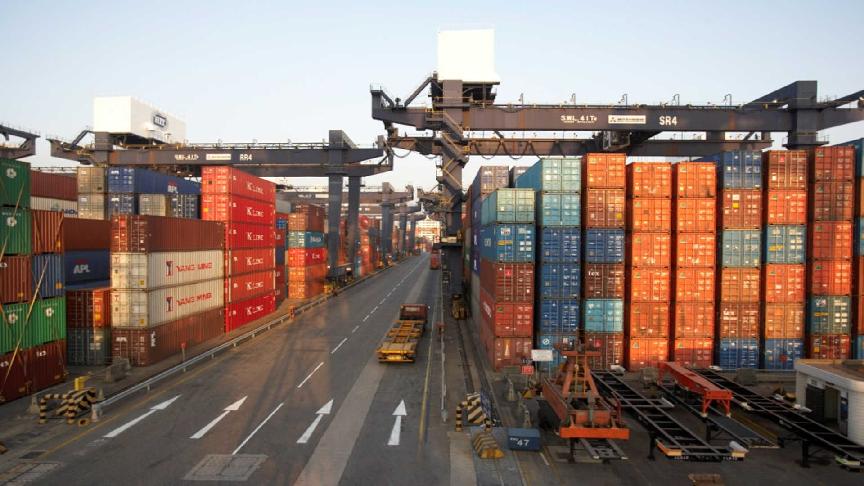- Stay ahead of supply chain disruptions and port congestion with Kuehne+Nagel’s weekly port operational update.
- Find out the latest vessel waiting times and status of ports in Africa, Asia, Oceania, Europe, the Middle East-Indian Subcontinent, North America, and South and Central America.
Africa
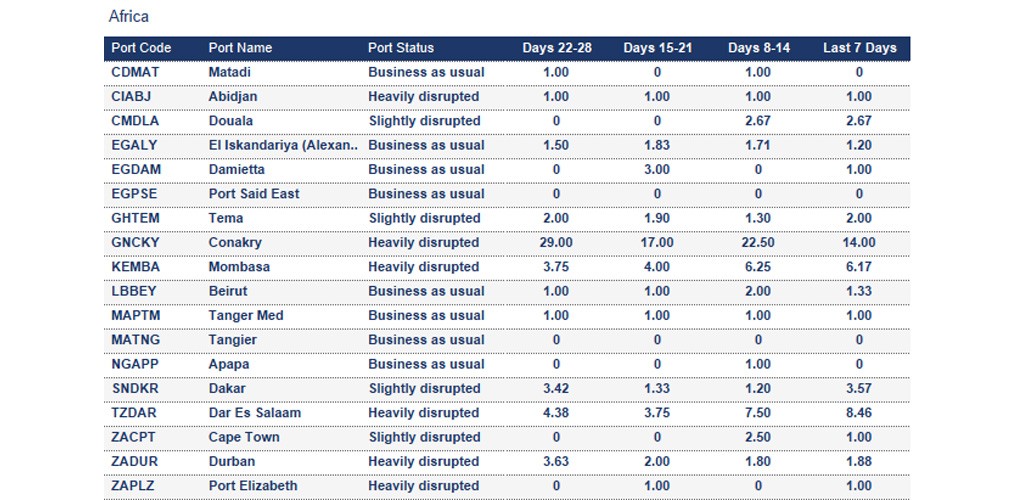
Ghana
Tema: The 7-day average vessel waiting time is 2 days. On-window vessels wait on average a day for a berth, while off-window arrivals wait up to 3 days. The terminal is currently powered by generators only; therefore, operations are limited.
Mozambique
Beira: The 7-day average vessel waiting time is around 11.5 days due to congestion and severe weather.
Maputo: Some carriers report waiting times of up to 4 days.
Nigeria
Tincan/Lagos: Carriers report waiting times of up to 4 days.
Republic of the Congo
Pointe Noire: The 7-day average vessel waiting time is around 4 days.
South Africa
Cape Town: The 7-day average vessel waiting time is around 1 day. Strong winds are expected until the end of week 46 with possible stoppages. Yard space constraints due to simultaneous handling of breakbulk and containerised cargo.
Durban: The 7-day average vessel waiting time is around 1.88 days. Durban faces delays from crane replacement at Pier 2 and vessel bunching. Bayhead Road rehab causes intermittent truck congestion. Heavy winds and rain are expected in November. Carriers may adjust rotations or omit Durban calls to maintain schedule reliability.
Port Elizabeth: Strong winds are forecast until the end of the week. Due to the citrus season, the reefer demand is high.
Asia Oceania
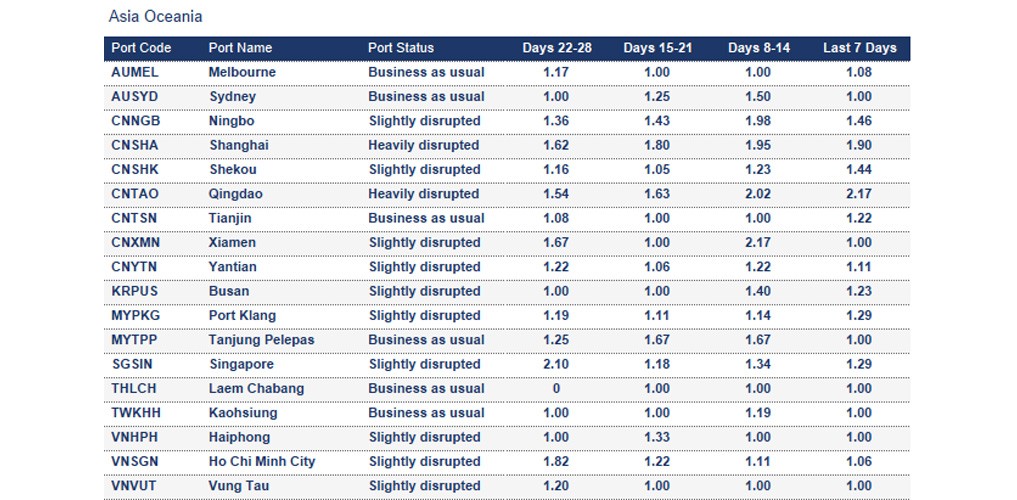
Malaysia
Port Klang: The average vessel waiting time is approximately 1.29 days due to berth congestion and vessel bunching. The yard density is at around 82%.
Philippines
Manila: The 7-day average vessel waiting time is around 2.42 days due to port congestion after tropical storm FUNG-WONG.
Vietnam
Haiphong: The 7-day average vessel waiting time is around 1 day due to port congestion.
Ho Chi Minh City: The 7-day average vessel waiting time is around 1.06 days due to ongoing port congestion.
Vung Tau: The 7-day average vessel waiting time is around 1 day due to port congestion.
Europe

Belgium
Several days of strikes are planned across Belgium with an impact on cargo and passenger rail between 24 and 26 November. Read more.
Antwerp: The 7-day average vessel waiting time is around 1.17 days. The port is currently severely congested due to recent storm closures, labour shortages, as well as a severe yard congestion of up to around 90% for dry and reefers.
Germany
Hamburg: A demonstration on 7 November was causing a full stop of the railway in the port of Hamburg, especially for EKOM, CTB and the HCCR. Additionally, those terminals were also not able to be entered by truck. The 7-day average vessel waiting time is around 1.21 days.
Hamburg terminals remain under pressure: yard steady at 75–80%, reefers at 50%. Construction since September has reduced berth capacity; crane maintenance next week will cut craneage, limiting flexibility. Delays persist, though recovery plans include diversions and shifts to Unikai. Fog risk may impact schedules; a new gantry in December offers relief. The backlog at CTB for rail is currently 18 hours, 8 hours at EKOM.
Italy
Rail interruptions due to maintenance were extended and are expected to remain for parts of 2026. Read more.
Genoa: The 7-day average vessel waiting time is at around 1.6 days. Yard density remains elevated at 77%.
Netherlands
Rotterdam: The 7-day average vessel waiting time is around 1.85 days. Netherlands terminals stable overall: ECT yard at 75%, delays for barges/feeders 12–24 hrs. MVII yard 80%, rising to 100%. Delta II yard low at 49%, reefers 20%, ITT challenges persist.
Portugal
Planned strikes across multiple sectors in the country are expected to cause cargo transport delays in November and December. Read more.
Leixoes: The -day average vessel waiting time is around 2 days.
Réunion
Port de Pointe des Galets: Waiting times are increasing, and some operational challenges are being encountered. Transshipments from Port Louis have been delayed due to carriers’ irregular schedules on direct services. Alternative routings via outlying transhipment hubs are causing extended transit times. Cargo may remain in Port Louis until the next available direct sailing.
Spain
Valencia: The 7-day average vessel waiting time is around 3 days due to the aftermath of the severe storm in week 44. The yard density is high at 88%.
Turkey
Izmir: The yard is at around 80%.
United Kingdom
Felixstowe: The 7-day average vessel waiting time is around 2.75 days.
Grangemouth: Due to the ongoing weather-related issues in the last weeks, there is currently a reefer plug-in shortage. The yard is at 80%.
London Gateway Port: The yard is at 63% with reefers at around 55%. The berth is fully occupied.
Southampton: The 7-day average vessel waiting time is around 4 days. Yard utilisation is high: Dry at 88%, Reefers at 95%. The schedule remains busy with vessel delays consuming available white space. Crane gangs are at good levels. Note: Pilot station closure occurred on Friday and Saturday last week.
Middle East - Indian Subcontinent

Sri Lanka
Colombo: Terminal operations have been adversely affected due to high yard congestion, increased transhipment volumes, and unfavourable weather conditions. Transshipments might face delays.
United Arab Emirates
Jebel Ali: Productivity is currently being impacted due to operational delays arising from crane malfunctions.
North America
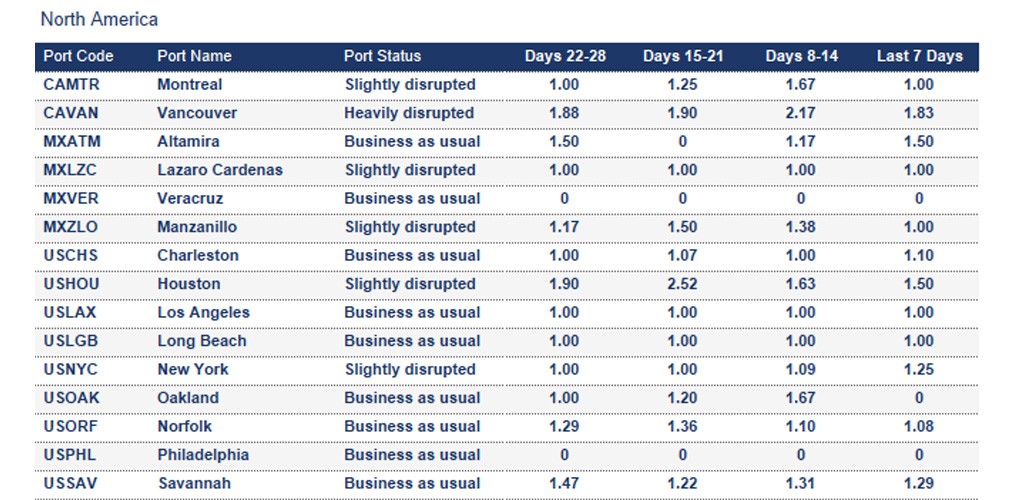
Canada
Average import rail dwell time for Canadian cargo (Vessel arrival to departure rail ramp):
- Halifax: 4 days
- Montreal: 7 days
- Prince Rupert: 6 days
- Saint John: 5 days
- Vancouver: 7 days
Mexico
The Frente Nacional de Productores y Consumidores de Maíz (FNRCM) has announced a strike and blockade of highways and customs checkpoints on 24 November across the country, which is likely to interrupt cargo transport in affected areas.
Manzanillo: The 7-day average vessel waiting time is around 1 day. Appointment scheduling has improved significantly; Manzanillo operations are smooth with no protests in Guanajuato or the Bajío region. Rail platform assignments follow delayed containers, but operations may face disruption due to the La Barca blockade.
United States
Houston: The 7-day average vessel waiting time is around 1.5 days.
New York: Some carriers report waiting times of up to 3 days. One crane at the south berth will be out of service until the end of November.
South and Central America
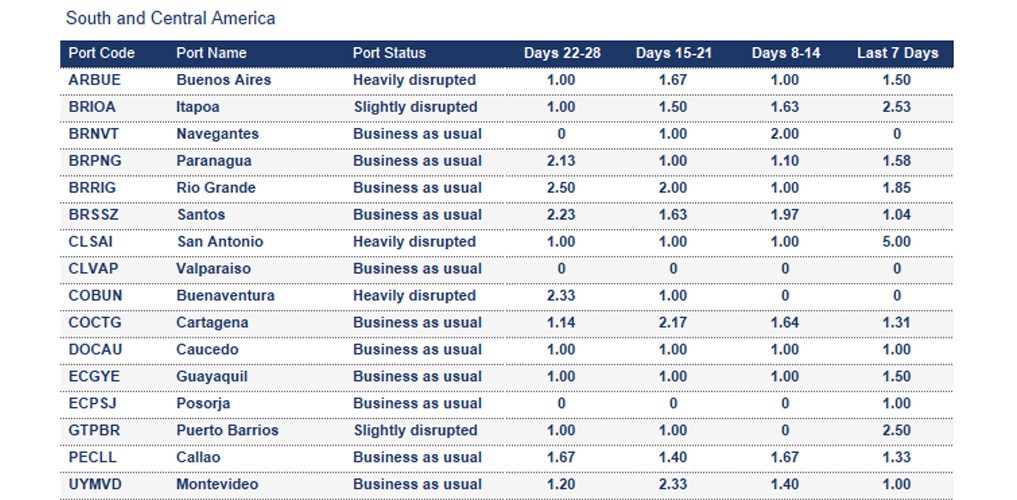
Chile
Puerto Angamos: As of 10 November the access to the terminal is currently restricted following industrial action by port personnel. This disruption is impacting normal operations and may lead to delays in cargo handling and vessel scheduling. Negotiations are expected to resume shortly, with the aim of restoring standard service levels and minimising further operational impact.
San Antonio: The 7-day average vessel waiting time is 5 days.
Colombia
Buenaventura: Previously, operations were disrupted due to route blockages, which have now ended. However, challenges remain: port congestion, significant truck appointment delays, and a shortage of trucks are impacting efficiency. Additionally, there are safety concerns at the port route entry and exit, requiring extra caution.
Costa Rica
Caldera: The 7-day average vessel waiting time is around 3 days. The port is currently congested, and the infrastructure is not able to cope with the volume influx, leading to fluctuating levels of disruptions. Import containers for general cargo typically become available approximately three to six days after the vessel's operation at the port, due to yard mobilisation. For reefer and IMO cargo, handling is conducted directly at the port.
How Kuehne+Nagel estimates port disruption statuses
Seaexplorer has four port statuses that are estimated based mainly on the 7-day average vessel waiting time. Other factors include yard congestion, labour strikes, natural disasters or intermodal disruptions. Slightly different rules are applied to major ports, or ports that are hubs in their region, as they are typically more efficient.
- Business as usual means the port is currently operating without any significant disruption;
- Slightly disrupted is used if the 7-day average vessel waiting time exceeds 2 days;
- Heavily disrupted is used if the 7-day average vessel waiting time exceeds 4 days; and
- Port closed is used when the port suspends operations due to a major disruptive event.
How Kuehne+Nagel calculates the 7-day average vessel waiting time
Mainline container vessels may spend a certain number of days waiting at designated anchorage areas before their scheduled port call.
To calculate the 7-day average waiting time, we consider the waiting days of these vessels, excluding:
- Waiting times for feeder vessels,
- Idle ships without an announced next port,
- Slow steamers heading toward the anchorage but not actively waiting within the designated area
- Vessels passing through the anchorage area without intending to call at the port.
This rolling average is based on the data from the last seven days and is updated daily in seaexplorer.
To find the latest waiting time for a port, enter the port name or code in the search bar and select the relevant option.
Stay Ahead Stay Informed: Register for seaexplorer for the latest disruptions and vessel waiting times at global container ports.


